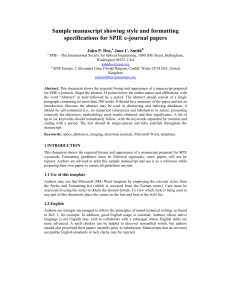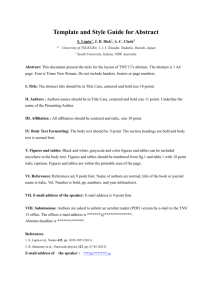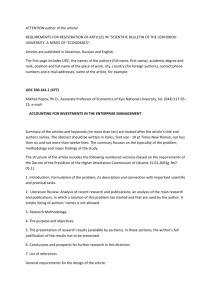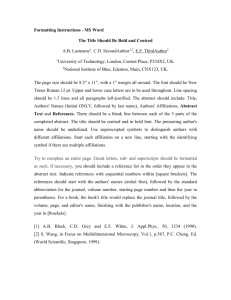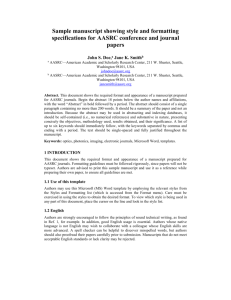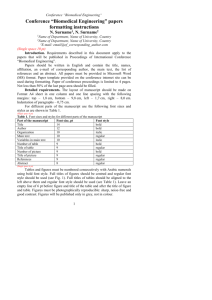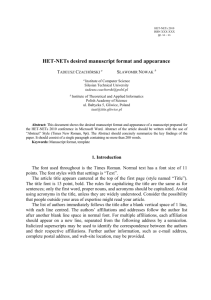Sample manuscript showing style and formatting
advertisement
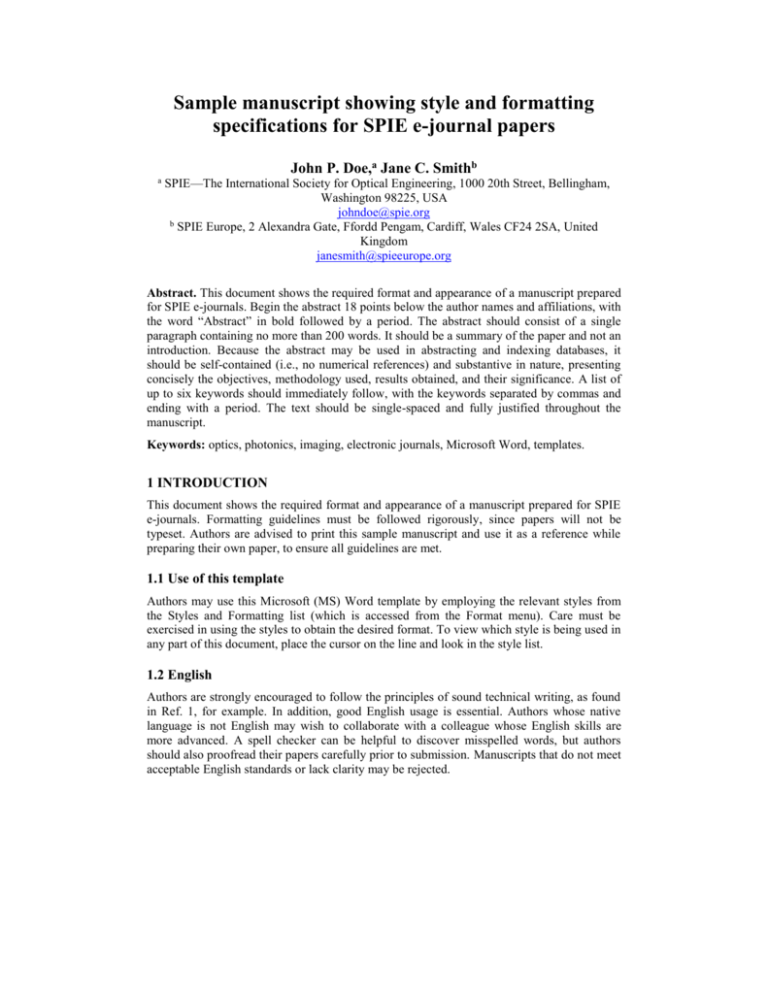
Sample manuscript showing style and formatting specifications for SPIE e-journal papers John P. Doe,a Jane C. Smithb a SPIE—The International Society for Optical Engineering, 1000 20th Street, Bellingham, Washington 98225, USA johndoe@spie.org b SPIE Europe, 2 Alexandra Gate, Ffordd Pengam, Cardiff, Wales CF24 2SA, United Kingdom janesmith@spieeurope.org Abstract. This document shows the required format and appearance of a manuscript prepared for SPIE e-journals. Begin the abstract 18 points below the author names and affiliations, with the word “Abstract” in bold followed by a period. The abstract should consist of a single paragraph containing no more than 200 words. It should be a summary of the paper and not an introduction. Because the abstract may be used in abstracting and indexing databases, it should be self-contained (i.e., no numerical references) and substantive in nature, presenting concisely the objectives, methodology used, results obtained, and their significance. A list of up to six keywords should immediately follow, with the keywords separated by commas and ending with a period. The text should be single-spaced and fully justified throughout the manuscript. Keywords: optics, photonics, imaging, electronic journals, Microsoft Word, templates. 1 INTRODUCTION This document shows the required format and appearance of a manuscript prepared for SPIE e-journals. Formatting guidelines must be followed rigorously, since papers will not be typeset. Authors are advised to print this sample manuscript and use it as a reference while preparing their own paper, to ensure all guidelines are met. 1.1 Use of this template Authors may use this Microsoft (MS) Word template by employing the relevant styles from the Styles and Formatting list (which is accessed from the Format menu). Care must be exercised in using the styles to obtain the desired format. To view which style is being used in any part of this document, place the cursor on the line and look in the style list. 1.2 English Authors are strongly encouraged to follow the principles of sound technical writing, as found in Ref. 1, for example. In addition, good English usage is essential. Authors whose native language is not English may wish to collaborate with a colleague whose English skills are more advanced. A spell checker can be helpful to discover misspelled words, but authors should also proofread their papers carefully prior to submission. Manuscripts that do not meet acceptable English standards or lack clarity may be rejected. 1.3 Page setup and fonts All text and figures, including footnotes, must fit inside a text area 5.25 in. wide by 8.5 in. high (13.28 by 21.54 cm). Margins should be 1.0 in. (2.54 cm) on the top and 1.625 in. (4.11 cm) on the bottom, left, and right. Use Times New Roman font throughout the manuscript, in the sizes and styles shown in Table 1. If this font is not available, use a similar serif font. The manuscript should not contain headers or footers. Pages should not be numbered. The page numbers will be added by the publisher after acceptance. Table 1. Font sizes and styles. Style name Brief Description Article Title 16 pt, bold Author Names 12 pt, bold Author Affiliations Abstract Keywords 10 pt 10 pt 10 pt HEADING 1 Heading 2 11 PT, BOLD 11 pt, bold Heading 3 Paragraph 11 pt, italic 10 pt Figure caption Table caption 9 pt 9 pt 2 PARTS OF A MANUSCRIPT This section describes the normal structure of a manuscript and how each part should be handled. In this template, paragraph spacing is done automatically. For example, the appropriate space is automatically added after section headings, and section headings always fall on the same page with the first two lines of the paragraph that follows. Therefore, it should rarely be necessary to force a page break to avoid widows/orphans. Also, note that only a single space should be added between sentences. 2.1 Title and author names The article title appears centered at the top of the first page. The title font is 16 pt, bold. The rules for capitalizing the title are the same as for sentences; only the first word, proper nouns, and acronyms should be capitalized. Do not begin titles with articles (e.g., a, an, the) or prepositions (e.g., on, by, etc.). Avoid the use of acronyms in the title, unless they are widely understood. Appendix A contains more about acronyms. The list of authors immediately follows the title, 18 points below. The font is 12 pt, bold and the author names are centered. The author affiliations and addresses follow the names, in 10-pt, normal font and centered. For multiple affiliations, each affiliation should appear on a separate line. Superscript letters (a, b, c, etc.) should be used to associate multiple authors with their respective affiliations. The author e-mail addresses should follow the affiliations on a separate line, in 10-pt font, centered, and hyperlinked. 2.2 Abstract and keywords The title and author information are immediately followed by the abstract. The abstract should concisely summarize the key findings of the papers in a single paragraph containing no more than 200 words. The abstract does not have a section number. A list of up to six keywords should immediately follow the abstract, 6 points below. The word “Keywords” should be formatted in bold and followed by a colon. Keywords should be separated by commas and end with a period. Do not use acronyms in the keywords. 2.3 Body of paper The body of the paper consists of numbered sections that present the main findings. These sections should be organized to best present the material. See Section 3 for section formatting instructions. 2.4 Appendices Auxiliary material that is best left out of the main body of the paper may be included in the appendices, for example, derivations of equations, proofs of theorems, and details of algorithms. Appendices are enumerated with upper-case Latin letters in alphabetic order. 2.5 Acknowledgments In the acknowledgments section, which appears just before the references, the authors may credit others for their guidance or help. Also, funding sources or sponsorship information may be stated. The acknowledgments section does not have a section number. 2.6 References The References section lists books, articles, and reports that are cited in the paper. This section does not have a section number. The references are numbered in the order in which they are cited. Examples of the format to be followed are given at the end of this template. For books [1,2] the listing includes the list of authors (initials plus last name), book title (in italics), page or chapter numbers, publisher, city, and year of publication. Journal article references [3,4] include the author list, title of the article (in quotes), journal name (in italics, properly abbreviated), volume number (in bold), inclusive page numbers or citation identifier, and year. A reference to a proceedings paper or a chapter in an edited book [5,6] includes the author list, title of the article (in quotes), conference name (in italics), editors (if appropriate), volume title (in italics), volume number if applicable (in bold), inclusive page numbers, publisher, city, and year. The references are numbered in the order of their citation. Citations to the references are made using brackets around the numerals, as demonstrated in the preceding paragraph. Place references before commas, periods, and colons. Two or more references should be separated by a comma with no space between them. Multiple references should be displayed with a dash between the first and last numbers [1-4]. One may also directly refer to a reference within the text, e.g., “as shown in Ref. 3....” Footnotes may used to provide auxiliary information that doesn’t need to appear in the text, e.g., to explain measurement units. They should be used sparingly. * 2.6.1 Reference linking and DOIs A Digital Object Identifier (DOI) is a unique alphanumeric string assigned to a digital object, such as a journal article or a book chapter, that provides a persistent link to its location on the internet. The use of DOIs allows readers to easily access cited articles. Authors should include * To insert a footnote, use the Insert menu, select Reference, then Footnote, change the number format to the style of asterisk, dagger, double-dagger, etc., and click OK. the DOI at the end of each reference in brackets, if a DOI is available. See examples at the end of this manuscript. A free DOI lookup service is available from CrossRef at http://www.crossref.org/freeTextQuery/. The inclusion of DOIs will facilitate reference linking and is highly recommended. 2.7 Biographies A brief professional biography not to exceed 150 words may be provided for each author, if available. Biographies should be placed at the end of the paper, after the references. Personal information such as hobbies or birthplace/birthdate should not be included. 3 SECTION FORMATTING Type each section heading on a separate line using the appropriate style from the style list. Sections should be numbered sequentially, starting with the first section after the abstract, except for the acknowledgments and references. (Note that numbering of section headings is not required, but the numbering must be consistent if used.) All section headings should be left justified. Main section headings are in 11-pt, bold font and in all capital letters. The heading starts with the section number. Paragraphs that immediately follow a section heading are leading paragraphs and should not be indented, according to standard publishing style. The same goes for leading paragraphs of subsections and sub-subsections. Subsequent paragraphs are standard paragraphs, with 0.2in indentation. There is no additional space between paragraphs. In this MS Word template, use the Paragraph 1 style for leading paragraphs and the Paragraph 2 style for all subsequent paragraphs. 3.1 Subsection headings Only the first word of a subsection heading is capitalized. The rest of the text is not capitalized, except for proper names and acronyms (the latter should only be used if well known). Subsection numbers consist of the section number, followed by a period, and the subsection number within that section, without a period at the end. The heading is left justified and its font is 11 pt, bold. 3.1.1 Sub-subsection headings The first word of a sub-subsection is capitalized. The rest of the text is not capitalized, except for proper names and acronyms (the latter should only be used if well known). The heading is left justified and its font is 11 pt, bold. 4 FIGURES AND TABLES 4.1 Figures Figures are numbered in the order in which they are called out in the text. They should appear in the document in numerical order and as close as possible to their first reference in the text. It may be necessary to move figures or tables around to enhance readability Figures, along with their captions, should be separated from the main text by 0.2 in and centered. Figure captions are centered below the figure or graph. Figure captions start with the abbreviation “Fig.” in front of the figure number, followed by a period, and the text in 9-pt font. See Fig. 1 for an example. Fig. 1. Example of a figure caption. 4.2 Tables Tables are numbered in the order in which they referred to. They should appear in the document in numerical order and as close as possible to their first reference in the text. It is preferable to have tables appear at the top or bottom of the page, if possible. Table captions are handled identically to those for figures, except that they appear above the table. See Table 1 for an example. 4.3 Multimedia (video and audio) Please refer to the multimedia guidelines on the journal homepage for specific submission guidelines and requirements. The following types of multimedia files are accepted: QuickTime Non-Streaming video (.qt or .mov), MPEG (.mpg or .mp4), DV (.dv), for video and PCM, WAV, AIFF, MP3 for audio. The recommended maximum size for each multimedia file is 3 MB. For larger multimedia files, authors should contact the publisher for guidance. Authors must insert a representative “still” image from the video file in the manuscript as a “figure.” This still image will be linked by the publisher to the actual video file, as will the caption label. For audio files, use the icon shown below as a placeholder. This audio icon will be linked by the publisher to the actual audio file, as will the caption label. Video and audio files should be named Video 1, Video 2, etc., and Audio 1, Audio 2, etc., respectively. Otherwise multimedia files are treated in the same manner as figures. The multimedia file type should be included in parentheses at the end of the figure caption, along with the file size. See Video 1 and Audio 1 for examples. Video 1. Example of a multimedia still image (MPEG, 2.5 MB). Audio 1. This icon is to be used as a placeholder for audio files (WAV, 1.2 MB). APPENDIX A: MISCELLANEOUS FORMATTING DETAILS It is often important to refer back (or forward) to specific sections. Such references are made by indicating the section number, for example, “In Sec. 2 we showed…” or “Section 2.1 contained a description….” When the section reference starts a sentence, Section is spelled out; otherwise use its abbreviation, Sec. References to figures, tables, theorems, etc. are handled in the same way. At the first occurrence of an acronym, spell it out (unless it is widely known such as CCD, LED, UV), followed by the acronym in parentheses, e.g., noise power spectrum (NPS). At times it may be desired, for formatting reasons, to break a line without starting a new paragraph. Line breaks should be inserted using Shift+Enter instead of the Enter key. A.1 Formatting equations Equations may appear inline with the text, if they are simple, short, and not of major importance; e.g., a = b/c. Important equations appear on their own line. Such equations are centered. For example, “The expression for the field of view is 2a b 1 3c , (1) where a is the …” Principal equations are numbered, with the equation number placed within parentheses and right justified. Authors are strongly encouraged to use MS Word Equation Editor or MathType to create both in-text and display equations. Equations are considered to be part of a sentence and should be punctuated accordingly. In the above example, a comma appears after the equation because the next line is a subordinate clause. If the equation ends the sentence, a period should follow the equation. The line following an equation should not be indented unless it is meant to start a new paragraph. References to equations include the equation number in parentheses, for example, “Equation (1) shows …” or “Combining Eqs. (2) and (3), we obtain….” Note that the word “Equation” is spelled out if it begins a sentence, but is abbreviated as “Eq.” otherwise. A.2 Formatting theorems To include theorems in a formal way, the theorem identification should appear in a 10-pt, bold font, left justified and followed by a period. Formal statements of lemmas and algorithms receive a similar treatment. The text of the theorem continues on the same line in normal, 10pt font. For example, Theorem 1. For any unbiased estimator… Acknowledgments This unnumbered section is used to identify people who have aided the authors in accomplishing the work presented and to acknowledge sources of funding. References [1] G. J. Alred, C. T. Brusaw, and W. E. Oliu, Handbook of Technical Writing, 7th ed., St. Martin’s, New York (2003). [2] L. C. Perelman, J. Paradis, and E. Barrett, Mayfield Handbook of Technical and Scientific Writing, Mayfield, Mountain View, Calif. (1997). [3] A. Harris, J. J. Sluss, Jr., H. H. Refai, and P. G. LoPresti, “Free-space optical wavelength diversity scheme for fog mitigration in a ground-to-unmanned-aerialvehicle communications link,” Opt. Eng. 45, 086001 (2006) [doi:10.1117/1.2338565]. [4] N. Metropolis, A. W. Rosenbluth, M. N. Rosenbluth, A. H. Teller, and E. Teller, “Equations of state calculations by fast computing machine,” J. Chem. Phys. 21, 1087-1091 (1953). [5] S. F. Gull, “Developments in maximum-entropy data analysis,” in Maximum Entropy and Bayesian Methods, J. Skilling, Ed., pp. 53-71, Kluwer Academic, Dordrecht, Netherlands (1989). [6] K. M. Hanson, “Introduction to Bayesian image analysis,” in Image Processing, M. H. Loew, Ed., Proc. SPIE 1898, 716-731 (1993) [doi:10.1117/12.154577]. John P. Doe is an assistant professor at the University of Ohio. He received his BS and MS degrees in physics from the University of Washington in 1985 and 1987, respectively, and his PhD degree in optics from the Rochester Institute of Technology in 1991. He is the author of more than 50 journal papers and has written three book chapters. His current research interests include optical interconnects, holography, and optoelectronic systems. He is a member of SPIE. Jane C. Smith: biography not available.
